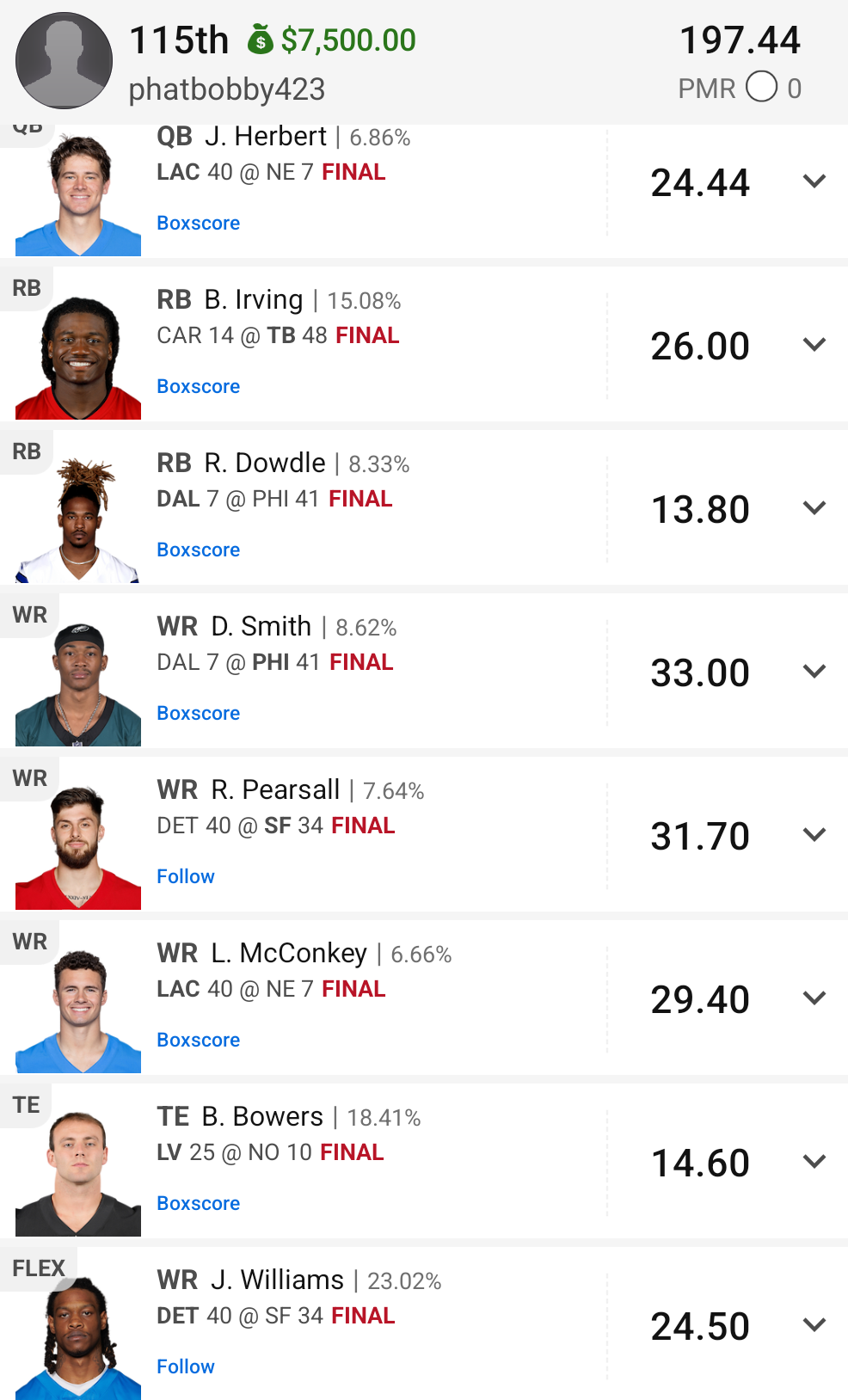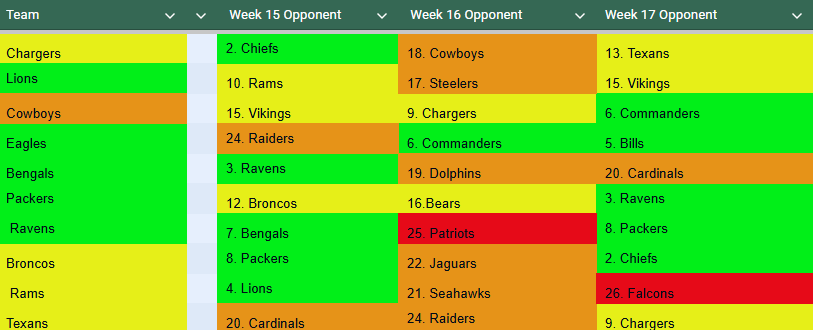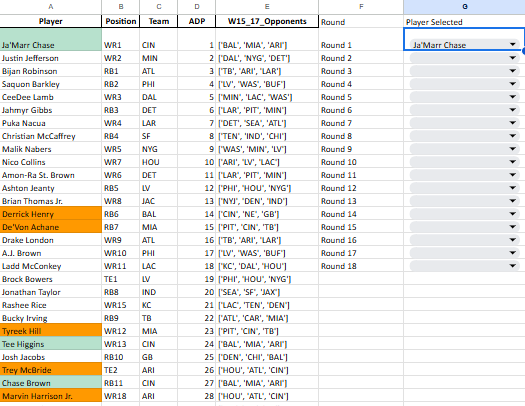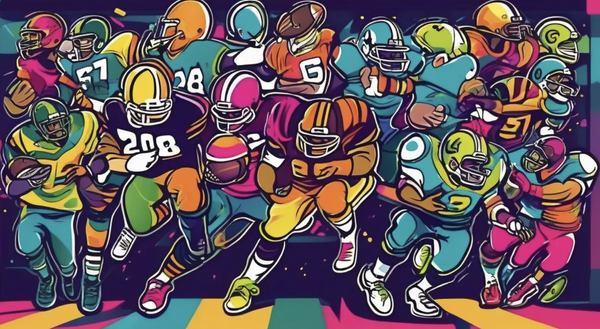The Best Ball Strategy That Won Me Over $10,000 in 2024
We all love week 17 correlation, but what if we, like Emeril Lagasse, take it up a notch and BAM!

If you’re new to Best Ball, you may not realize that a lot of dorks and nerds play it. How do I know? Well… I’m one of those nerds.
What Is Best Ball, Anyway?
For those who don’t know, you’re missing out.
The premise is simple: after you draft your fantasy team, you’re done managing it. Each week, your highest-scoring lineup is automatically set from your roster. Best Ball let me do over 100 drafts last year, which turned out to be great practice for my season-long redraft leagues.
Frankly, drafting is the most fun part for me, so why not do it a lot? A LOT A LOT. I DON’T HAVE A PROBLEM, YOU DO!
The “Rules” of Best Ball (or, The Cult of Correlation)
There are many so-called “rules” in the Best Ball streets — repeated ad nauseam by content creators until they become sacred mantras.
Okay, maybe that’s a bit dramatic. However, Best Ball players genuinely believe they’re doing it the best.
So, in the spirit of keeping that tradition alive, I’m here to tell you about the strategy that helped me win $10,000 last season.
To be clear: I was inches away from even more. One Ladd McConkey catch — one Justin Herbert pass not missing by a fingertip — and I would have cracked the top 50 out of 880,000 entries. This is not a criticism of either player, their outstanding performances carried me that week and throughout the season, the point is that I was really, really, really close to some seriously life-changing money. As it stood, I finished 115th, bagging $7,500. Toss in some other winnings, and I crossed the $10,000 mark for the year.

I’m not trying to brag — okay, maybe a little — but in the Best Ball world, people often want to know if you have the receipts. That said, if you’ve been around long enough, even if you’ve never placed big, we’ll still keep you around… for vibes.
What Is Correlation and Why Does It Matter?
One of the key concepts in Best Ball is week 17 correlation.
If you’re familiar with DFS (Daily Fantasy Sports), you know the idea: you don’t just target players — you target games. If a game blows up, and you have players on both sides, you’re riding the points wave.
In Best Ball, this has evolved into the mantra of Week 17 correlation, because Week 17 is typically when the big finals happen. Nail the right Week 17 game stack, and you could win serious money.
If you want an in-depth article fleshing this concept and many other concepts out, one of my favorite best ball articles: Best Ball Mania Manifesto: A Guide To Winning Big On Underdog Fantasy
Or if you're a listener, not a reader, the concept gets discussed well here in Peter Overzet’s Week 17 Is All That Matters video
Some people are so invested in this that they memorize Week 17 matchups the moment the NFL schedule is released.
Is it sad that I knew all the Week 17 games before training camp even started? You’re not my therapist, George — don’t answer that. (But seriously: follow, comment, subscribe!)
Week 15, Week 16… Why Not All?
Naturally, the community loves to debate. After everyone jumped on the Week 17 bandwagon, another group emerged: the Week 15 homies.
Their argument? Week 17 only matters if you make it there. You’re not making it unless you stack smartly for Week 15. So, should we focus on Week 15? Week 16? Week 17?
Here’s my take: why pick just one?
You can have your cake and eat it too. And as your resident chubby man, trust me — I know cake.
Stacking Correlation (aka Correlation Trees)
Let’s kick this up a notch.

I call it Correlation Trees — stacking across Week 15, 16, and 17 all at once by being intentional with your player and team choices.
For example, if you stack two games in Week 17, you can also make sure those teams face each other (or other stacked teams) earlier in the playoffs.
Say you stack the Chargers, Cowboys, Commanders, and Texans. You get two correlated Week 17 games and Week 16 correlation between the Chargers and Cowboys. Beautiful.
Proof It Works: How Correlation Took Me to the Finals
As we can see with this table, my team last year had 50% or higher correlation each playoff week. In fact, it went from 65% in Week 15, to 60% in Week 16, and 50% in Week 17.
By intentionally building correlation across multiple matchups each week, I wasn’t just crossing my fingers — I was stacking the deck (pun intended).
If you have a team packed with players in all the biggest games that pop off during those three weeks, that’s how you make the finals — and maybe, just maybe, how you win the $2 million top prize this year.
For my visual folks here, here are examples of how this might look in a web/network with who faces who, what weeks, with specific players for this year as an example, using their ADP. I’m not saying these are good teams, but examples of correlation trees.
This one doesn’t include the listed weeks, so it’s a bit cleaner visually.
Tools to Build Your Correlation Trees
I’ve created two free tools to help you out:
1️: Offensive Correlation Rankings
I built team playoff target rankings based on trusted sources, overlaying each team’s playoff schedule and adding my own ratings for weather impact.
The goal? Target players in good offenses playing in favorable weather for high-scoring, competitive games.
Sure, sometimes you want one-sided matchups — but as I painfully learned with Justin Herbert and Ladd McConkey vs. the Patriots last year, blowouts can get your stars benched early. I want competitive shootouts, not snoozefests.
Feel free to create your own version of this with your own rankings.
Here are my top 10 teams and their playoff week matchups

2️: The Correlation Tree Draft Tool
During your drafts, this tool will:
The left side of the sheet. Highlight players who stack with guys you already drafted (in green) Highlights players who correlate in any playoff week (in orange)

The right side of the sheet gives a list view. Show stacking + correlating options in ADP order.

Make a copy, edit for yourself, and enjoy! I’ll aim to update the ADPs every two weeks throughout the summer.
Final Thoughts: Don’t Get Too Rigid
Look, you don’t have to only draft players who fit into these trees. But as you build teams, think ahead.
Some drafts, you’ll go heavy on correlation; others, less so. However, stacking across all three playoff weeks gives you statistically supported upside.
If you’re a sports fan, you probably already get this instinctively: teams heat up late in the season. By riding with a team in three competitive, high-scoring games, you’re balancing season-long variance and setting yourself up for an underdog-to-champion run.
TL:DR
Correlate across Weeks 15–17
Use correlation trees to maximize playoff upside
Don’t stress about perfection, but be intentional
Cake is important
Want to see my tools or chat Best Ball nerdery? Subscribe — I promise, I’m only mildly insufferable.



